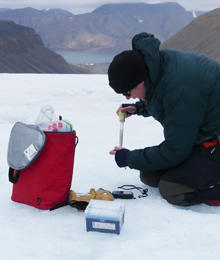An interview with Dr Arwyn Edwards
March 2020
Dr Arwyn Edwards is a Senior Lecturer at the University of Aberystwyth and a member of the Microbiology Society. In this interview, he tells us more about his research on microbes in extreme environments, how it has an impact and why microbiology matters.

Tell us more about your research
My research has focused on the microbiology of some of the coldest habitats imaginable: glaciers. Glacial ice covers 11% of Earth’s surface and holds about 70% of freshwater. Glaciers and ice sheets are vast, but are both victims and sentinels of climate change. Although 19th century polar explorers discovered that microbes inhabited glaciers and concluded they were the “greatest enemy to the mass of ice”, glacial microbiology has been neglected until the last decade. While glacial ice is a vast cold-store of microbes (some 4×1029 cells are immured in the glacial biome), the melting surfaces of glaciers and ice sheets are home to the most active and biodiverse ecosystems. Ice surfaces darkened by microbes absorb more solar energy, thus accelerating their melting rate: so-called biological darkening. The most recent IPCC report on climate impacts in the cryosphere highlighted biological darkening’s potential impact and the need for further work to resolve the scale of its impact as a climate feedback.
Why is this research important?
It would be easy to consider extreme environments as having marginal importance. Nothing could be further from the truth. Most of Earth’s biosphere experiences extreme physical conditions, principally in the form of low temperatures. So while extremes represent end-members in the spectrum of habitability, the microbes within them can be central to the function and future of the Earth system. Since the effects of anthropogenic climate change are amplified and accelerated in Earth’s coldest places, understanding the ways microbes thrive in the cold becomes crucial.
Irrespective of the potential for microbes to accelerate the loss of glaciers and ice sheets, these habitats are critically endangered. If we continue to emit greenhouse gases at the present rate, by the Microbiology Society’s 155th anniversary in 2100 up to 85% of Earth’s glaciers will have been lost. At present, a small fraction of the biodiversity of a small fraction of all glaciers has been mapped.
Why does microbiology matter?
The first 75 years of the Society’s history have seen the rekindled appreciation of glaciers as Earth’s largest freshwater ecosystems. Over the next 75 years I expect microbiologists will be kept busy exploring microbial life on glaciers and elucidating as many of its adaptations, applications, and amplifying feedbacks as possible – before it is too late.


